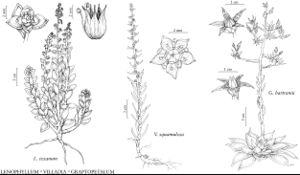Difference between revisions of "Lenophyllum"
Smithsonian Misc. Collect. 47: 159, figs. 18, 19, plate 20. 1904 ,.
FNA>Volume Importer |
FNA>Volume Importer |
||
| Line 21: | Line 21: | ||
|distribution=Tex.;ne Mexico. | |distribution=Tex.;ne Mexico. | ||
|discussion=<p>Species 7 (1 in the flora).</p><!-- | |discussion=<p>Species 7 (1 in the flora).</p><!-- | ||
| − | --><p>C. H. Uhl (1993, 1996) crossed four species of Lenophyllum with plants of Echeveria, Graptopetalum, or Pachyphytum, thus placing it in the same large comparium; it seemed less closely related to the other genera than they to each other. Also, in contrast to other genera of the comparium, where polyploids generally are autoploid, here all species studied appeared to be alloploids, although of unknown parentage.</p> | + | --><p>C. H. Uhl (1993, 1996) crossed four species of <i>Lenophyllum</i> with plants of <i>Echeveria</i>, <i>Graptopetalum</i>, or Pachyphytum, thus placing it in the same large comparium; it seemed less closely related to the other genera than they to each other. Also, in contrast to other genera of the comparium, where polyploids generally are autoploid, here all species studied appeared to be alloploids, although of unknown parentage.</p> |
|tables= | |tables= | ||
|references={{Treatment/Reference | |references={{Treatment/Reference | ||
| Line 54: | Line 54: | ||
|publication year= | |publication year= | ||
|special status= | |special status= | ||
| − | |source xml=https://jpend@bitbucket.org/aafc-mbb/fna-data-curation.git/src/ | + | |source xml=https://jpend@bitbucket.org/aafc-mbb/fna-data-curation.git/src/8f726806613d60c220dc4493de13607dd3150896/coarse_grained_fna_xml/V8/V8_469.xml |
|genus=Lenophyllum | |genus=Lenophyllum | ||
}}<!-- | }}<!-- | ||
-->[[Category:Treatment]][[Category:Crassulaceae]] | -->[[Category:Treatment]][[Category:Crassulaceae]] | ||
Revision as of 18:06, 18 September 2019
Herbs, perennial, not viviparous, 1–7 dm, glabrous. Stems erect, branching near base, herbaceous. Leaves caducous, in basal rosettes and cauline, (± alike, gradually smaller distally), proximal opposite, distal alternate, (sometimes crowded at base), sessile, not connate basally; blade elliptic or ovate-lanceolate to oblanceolate, planoconvex, 1–2.5 cm, fleshy, base not spurred, margins entire; veins not conspicuous. Inflorescences terminal spikes, racemes, or narrow thyrses, (usually 2+ per node, rarely solitary). Pedicels: flowers subsessile. Flowers erect, 5-merous; sepals distinct, subequal; petals erect with outcurved tips, distinct, buff or dull yellow often marked with red; calyx and corolla not circumscissile in fruit; nectaries subquadrate; stamens 10; filaments of epipetalous stamens adnate to corolla base; pistils erect, nearly distinct; ovary base truncate tapering to slender, outcurved styles; styles 2+ times shorter than ovaries. Fruits erect. Seeds ellipsoid, finely grooved.
Distribution
Tex., ne Mexico.
Discussion
Species 7 (1 in the flora).
C. H. Uhl (1993, 1996) crossed four species of Lenophyllum with plants of Echeveria, Graptopetalum, or Pachyphytum, thus placing it in the same large comparium; it seemed less closely related to the other genera than they to each other. Also, in contrast to other genera of the comparium, where polyploids generally are autoploid, here all species studied appeared to be alloploids, although of unknown parentage.
